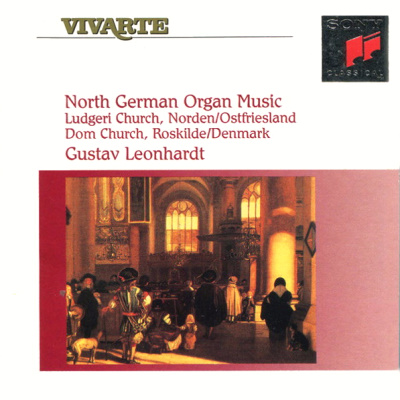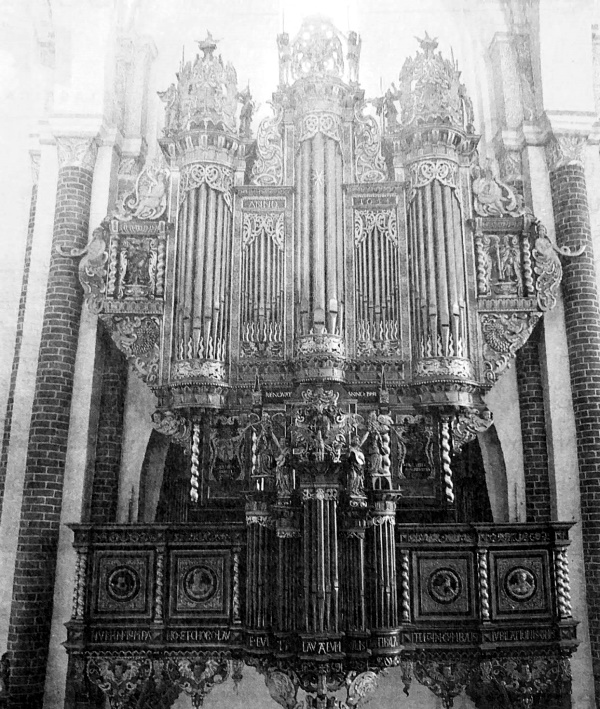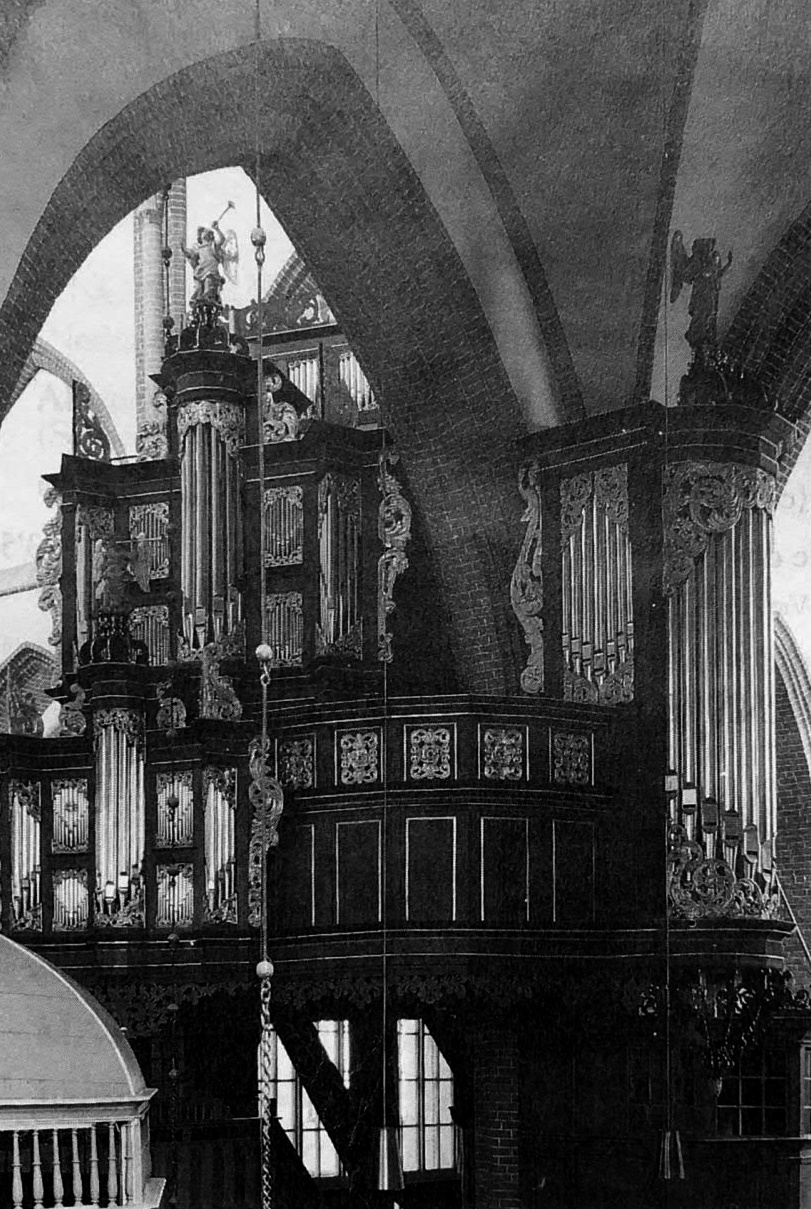 |
1 CD
-SK 53 371 - (p) 1993
|
|
NORTH GERMAN
ORGAN MUSIC
|
|
|
|
|
|
|
|
|
THE RAPHAËLIS
ORGAN IN ROSKILDE CATHEDRAL (DENMARK)
|
|
|
|
| Johann LORENTZ (c.1580-1650) |
Praeludium
in D minor |
|
2' 33" |
1 |
| Anonymous
(Netherlands, c.1630) |
Almande
d'amor |
|
3' 26" |
2
|
| Delphin STRUNGK
(c.1601-1694) |
Less mich Dein sein (Ach Herr,
mich armen Sünder) |
|
2' 24" |
3
|
| Peter MORHARDT (?-1685) |
Aus
tiefer Not schrei ich zu Dir |
|
3' 08" |
4 |
| Matthias WECKMANN (c.1619-1674)
|
Lucidor,
einst hütßt der Schaf |
|
2' 08" |
5 |
| Anonymous
(Netherlands, c.1650) |
3
Variations on "Daphne" |
|
4' 22" |
6 |
| Anonymous
(Netherlands, c.1610) |
Niederländisch
Liedgen "Windecken daer het bosch af
drilt"
|
|
2' 38" |
7 |
| Melchior SCHILDT (c.1592-1667) |
3
Variations on "Gleichwie das Feuer" |
|
3' 56" |
8 |
| Heinrich SCHEIDEMANN (c.1595-c.1663)
|
Galliarda
in D minor
|
|
4' 23" |
9 |
|
THE ARP
SCHNITGER ORGAN IN THE LUDGERI CHURCH AT
NORDEN / EAST FRIESLAND (GERMANY)
|
|
|
|
| Heinrich SCHEIDEMANN |
Praeludium
No. 11 in F major
|
|
1' 37" |
10 |
| Delphin STRUNGK |
3
Variations on the Magnificat "Meine Sehl
erhebet den Herrn"
|
|
9' 54" |
11 |
| Johann Adam REINCKEN (1623-1722) |
Fuga
in G minor |
|
4' 18" |
12 |
| Matthias WECKMANN
|
Canzona
in C minor
|
|
5' 57" |
13 |
| Georg BÖHM (1661-1733) |
2
Variations on "Vater unser im
Himmelreich" |
|
7' 15" |
14 |
| Christian RITTER (c.1645-c.1717)
|
Sonatina
in D minor |
|
4' 10" |
15 |
|
|
|
|
|
Gustav
Leonhardt, Organs
- Raphaëlis Organ in Roskilde
cathedral (Denmark) - Pitch: a' = 431
Hertz
- Arp Schnitger Organ in the Ludgeri
Church at Norden / East Friesland
(Germany) - Pitch: a' = 472 Hertz
|
|
|
|
|
|
Luogo
e data di registrazione |
|
Roskilde Domkerke
(Denmark) & Ludgerkirche,
Norden (Germany)
- 2-6 Novembre 1992
|
|
|
Registrazione:
live / studio |
|
studio |
|
|
Producer /
Recording Supervisor |
|
Wolf Erichson
|
|
|
Recording
Engineer
|
|
Stephan Schellmann
(Tritonus)
|
|
|
Prima Edizione
LP |
|
Nessuna
|
|
|
Edizione CD |
|
Sony "Vivarte" | LC
6868 | SK 53 371 | 1 CD - durata
63' 13" | (c) 1993 | DDD
|
|
|
Original Cover
|
|
"Sanctuary of a
Church" by Emanuel de Witte
(1617-1692).
|
|
|
Note |
|
-
|
|
|
|
|

The Raphaëlis Organ in
Roskilde Cathedral
(Denmark)
A mere glance at the case of
the Raphaëlis organ in
Roskilde Cathedral, with its
stylistic blend of Gothic,
Renaissance and Baroque
elements, is sufficient to
suggest the instrument’s
chequered history.
The beautiful Gothic canopy
beneath the organ dates from
around 1450. That an organ
already stood here even at
this early period may be
inferred from the fact that
instruments are attested in
the cathedral’s archives for
the years 1464 and 1484. In
1554 Herman Raphaëlis, a
Dutch builder from Bolsward
in Friesland, built a new
organ on this canopy. All
that remains of this
instrument are the gallery
balustrade, the Rückpositiv
case and four stops. The
Renaissance carvings were
the work of Per Jensoen from
Leeuwarden.
Exactly one hundred years
later - in 1654/55 - Gregor
Mülisch, a journeyman with
the late ]ohann Lorentz (ob.
1650), began a thorough
overhaul of the instrument,
including a replacement of
the entire case. Although
the Renaissance Rückpositiv
and gallery balustrade were
retained, both were
“modernized” with Baroque
elements carved by the
Roskilde woodcarver, Caspar
Lubbecke. Mülisch succumbed
to the plague in 1654 and
his work was completed in
1655 by “Peter Orgelbygger"
- probably the builder Peter
Karstensen Botz of Viborg.
The instrument now had three
manuals (Rückpositiv,
Manualwerk and Brustpositiv),
a Pedal and 29
stops.
It appears from a repair
estimate of 1761 that few
changes were made to the
organ during the next 180
years, since the builder
Hartvig Jochum Müller writes
here that “the organ has
never been repaired in more
than 100 years”. Müller's
quote is extremely detailed
and contains valuable
technical information
concerning the instrument.
His tender turned out to be
beyond the means of the
Roskilde authorities, with
the result that a local
clock-maker was entrusted
with the task of repairing
the instrument.
An important development in
the instrument’s fortunes
occurred in 1833, when
fundamental changes were
made to its design: in order
to enlarge the organ, it
proved necessary to saw away
the whole of the rear wall
of the main case. The pedal
pipes were now installed in
the vault behind the organ,
a move that later turned out
to be extremely
disadvantageous from both an
acoustic and technical point
of view. Furthermore, the Brustpositiv
was removed and replaced by
a small “Präludierwerk"
with swell. Finally, the
instrument was enlarged to
37 stops. This work was
undertaken by the young
organ builders, Jürgen
Marcussen and A. P. W.
Reuter, who had recently
made a name for themselves
with a large new organ for
the Castle Chapel in
Copenhagen. From the earlier
instruments of 1554 and
1654, Marcussen and Reuter
took over only the old Rückpositiv
windchest, the case pipes
(all of which date
from 1654) and a fairly
large number of intemal
pipes. In the process of
rebuilding the instrument,
the two builders made
extensive notes that proved
extremely useful at the time
of its most recent
restoration in 1988-91.
The organ was twice rebuilt
in the twentieth century. In
1926 the stop list was
increased to no fewer than
56 stops - almost twice as
many as in 1654. Because of
the confined space, the whole
technical operation was
extremely complicated, with
the result that by the 1950s
further restoration work had
again become necessary. The
1926 action - part
pneumatic, part mechanical -
was now made entirely
mechanical, and the stop
list and voicing were
retouched in a “Neo-Baroque”
spirit.
By the early 1980s it had
become clear that the organ
needed to be restored once
again: it could no longer be
relied on to function
technically; the old
windchests had dried out,
making it difficult to
maintain the same pitch; and
the sound was far from
homogeneous.
As a result, the organ was
examined by the Dutch organ
specialist, Cor H. Edskes,
between 1985 and 1987 and,
on the basis of his
findings, it was decided to
restore the instrument to
its 1654/55 state. It was
realized that there was no
future to the course adopted
since 1833 - constantly
enlarging the instrument.
The principal aim of the
reconstruction was to allow
the valuable old pipework of
1554 and 1654 to be heard
once again in its historical
context. The work was
carried out between 1988 and
1991 by the firm of
Marcussen & Son,
following the plans and
acting on the advice of Cor
H. Edskes. The voicing of
the instrument was
undertaken by Olav Qussoren.
Music flourished as never
before in Denmark during the
seventeenth century,
especially during the reign
of Christian IV (1588-1648),
when eminent musicians such
as John Dowland, Heinrich
Schütz, Melchior Schildt and
Matthias Weckmann held
appointments at court. The
Raphaëlis organ in Roskilde
Cathedral is the only
instrument of any size in
Denmark that still contains
substantial material from
this great past. With its
gentle, graceful sounds it
adds a significant facet to
the Northern European organ
landscape.
Kristian
Olesen

The Arp Schnitger organ in
the Ludgeri Church at
Norden / East Friesland
(Germany)
Arp Schnitger’s organ at
Norden had two predecessors,
of which eight ranks of
pipes have survived. The
oldest organ dated from
1566/67 and was the work of
the Groningen organ builder
Andreas de Mare. Within only
fifty years, the effects of
war had already made
extensive rebuilding a
matter of urgent necessity,
a task undertaken by Edo
Evers (Jever and Emden) in
1616-18. The instrument now
had eighteen stops
distributed among Hauptwerk,
Rückpositiv and Brustwerk,
together with a
non-independent Pedal.
But even this instrument did
not last long.
In December 1685 the church
authorities turned for help
to the famous Hamburg
builder Arp Schnitger and on
February 26, 1686 signed a
contract with him providing
for a 29-stop organ: 12
stops on the Oberwerk
(= Hauptwerk), 10 on
the Rückpositiv and
7 on the Pedal. The
contract further specified
that ten ranks of still
usable pipes, together with
the four bellows, should be
taken over from the old
organ. It appears from the
delivery note of January
1688 that Schnitger also
added a Brustpositiv
with 6 new stops, and in
1691/92 he went on to add an
8-stop Oberpositiv
coupled to the Brustpositiv.
The final stop list
comprised 46 speaking stops,
making the instrument the
largest in East Friesland.
A striking feature of the
Norden instrument - and it
is also an exception among
Schnitger's organs - is its
position within the church.
Taking as his starting-point
the existing site on the
southern wall of the choir,
where the instrument’s
predecessors had both been
located and where they had
functioned as choir organs,
he proceeded to build a new
gallery, somewhat lower than
the previous one and
projecting into the central
axis of the choir. It
extended so far round the
south-eastern pillar of the
crossing that the
pedal-tower was forced into
the transept. Necessarily
limited to a single
pedaltower, Schnitger none
the less followed an old
North German custom found in
many other laterally
situated organs. The manuals
speak diagonally into the
northern transept, with the
result that the organ, which
is mainly located in the
choir, can also be heard in
the transept and nave. The
instrument continues to
perform what at the time of
its inauguration was still a
novel function, namely,
accompanying the singing of
the congregation there.
The instrument survived the
next one and a half
centuries largely intact,
maintained by mostly East
Frisian builders. But from
the middle of the nineteenth
century onwards, changing
musical tastes demanded
“alterations to the entire
outmoded stop list in
keeping with the times".
Between 1847 and 1917 no
fewer than 20 original stops
fell victim to these
alterations. Further changes
and losses were incurred in
1917 when the metal from the
case pipes was melted down
for use in armaments, and
again in 1929/30, 1948 and
1957-59, when additional
restoration work was carried
out. Increasing damage was
also caused by the wood
drzing out and cracking.
Between 1981 and 1985 the
firm of Jürgen Ahrend
(Leer-Loga) undertook a
through restoration
programme based on strict
historical principles. Those
of the original parts of the
organ that were damaged were
repaired, altered sections
were restored, and the parts
that were no longer original
were reconstructed: into
this last category fell the
entire bellows mechanism,
including the wind
conductors, valves and
tremulants, part of the
action, the entire console,
25 stops and the case pipes.
All the evidence that could
be gleaned from the
instrument itself, together
with archive material and
old photographs, was taken
into account, and several
other Schnitger organs were
examined by way of
comparison or as possible
models. The whole operation
was planned by the present
incumbent, Reinhard Ruge, in
collaboration not only with
consultants appointed by the
regional church, namely, the
late Helmut Winter (until
the end of 1982) and Uwe
Droszella (since 1984) but
also with the builder
hlmself, Jürgen Ahrend.
In tuning the organ, we
opted for an irregular
mean-tone temperament
suggested by documentary
evidence concerning the
tuning practice adopted by
Schnitger and his contempo
raries (evidence collated bz
Harald Vogel), bz the 1688
deliverz note mentioned
above and bz surviving case
pipes from the Joachim
Kazser organ in Hohenkirchen
(1694/99). This is a
transitional form o
temperament between regular
mean-tone and equal
temperamemt. The scales used
in the seventeenth century
still contain mean-tone
intervals, although remote
keys with several sharps or
flats can also be used in
certain conditions. There is
no longer a “wolf fifth”,
and the purity of the major
thirds in the simpler keys
contributes considerably to
the beauty and clarity of
the organ’s tone and, hence,
to a recreation of its
original characteristics.
A decisive role in the
success of this restoration
was played by Jürgen Ahrend,
whose experience of
restoring important
historical organs dates back
over thirty years. His
building method rests on
“classical” principles and
has matured through
practical experience. When
combined with his artistic
skill at voicing organs,
this method made him seem
the obvious choice for the
present undertaking.
The Norden organ had already
been the subject of
considerable interest in the
musical world following the
rediscovery of the art of
North German organ music in
the 1920s. As a result of
its latest restoration, it
is now a particular
attraction for organists,
organ scholars, organ
builders and organ
enthusiasts from all over
the world. The tonal variety
of this second largest of
all Arp Schnitger's
surviving organs in Germanz,
the spatial arrangement of
its five departments and the
virtually original acoustics
of the church's medieval
interior, with its wooden
furnishings from the
Renaissance and Baroque,
conspire together in
felicitous fashion to
provide almost ideal
conditions for definitive
performances of
seventeenth-century North
German organ music.
Reinhard
Ruge
(Translation:
© 1993 Stewart Spencer)
|
  |
|
|